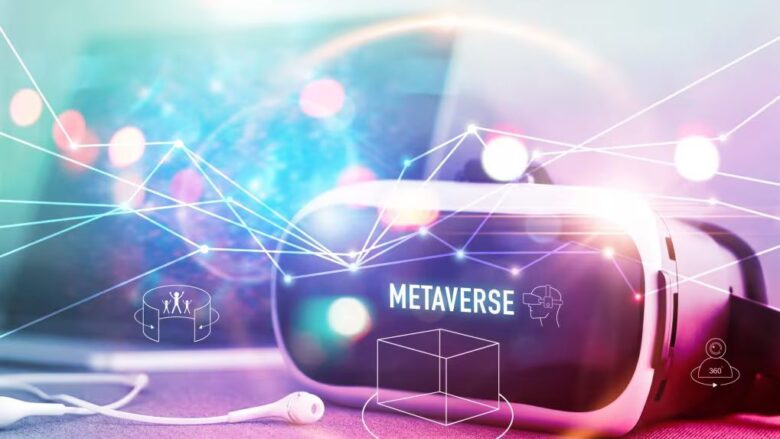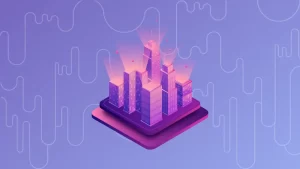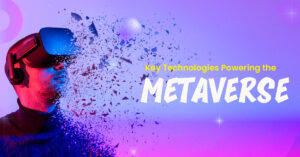Work, entertainment, socializing, and immersive shopping are just a few of the many things that make up the metaverse. It offers us an interconnected virtual world and has captured the interest of many people in recent years. What started as a simple idea has now become a major innovation area for global technology companies. The metaverse is evolving rapidly, but many of its promises remain unfulfilled thanks to advances in artificial intelligence (AI), blockchain technology, augmented reality (AR), and virtual reality (VR). Anyone who wants to participate in this exciting digital revolution needs to understand the evolution of the metaverse. We are only just beginning to understand what it will look like.
Technological Advances in the Metaverse:
The future of the metaverse will be largely influenced by continued technological innovation. Virtual and augmented reality are at the heart of the metaverse experience; they are only getting better. As VR and AR technology become cheaper, more powerful, and more widely adopted, the metaverse will become increasingly intriguing and immersive. For example, the next generation of VR headsets will provide users with a more realistic and immersive experience thanks to better motion tracking, higher resolution, and greater comfort. These developments will allow users to participate more fluidly in virtual environments, making the metaverse a second home.
Metaverse Artificial Intelligence:
In the future metaverse, artificial intelligence (AI) will be crucial, as it will enhance how users interact with digital environments. AI can help create more responsive and intelligent avatars, enabling more powerful interactions. AI-powered non-player characters (NPCs) can populate virtual landscapes, increasing their vibrancy and energy. AI will also help personalize the metaverse experience by understanding user preferences and habits and providing customized materials, suggestions, and experiences. As machine learning algorithms become more sophisticated, we can expect AI to predict user needs and improve the responsiveness of virtual environments in the future, making the metaverse more user-friendly and intuitive.
Blockchain and Decentralization:
Blockchain technology will also largely define the future of the metaverse. As more people create, sell, and trade virtual assets, the need for secure, decentralized systems grows. Blockchain provides a transparent, tamper-proof method of verifying digital ownership and ensuring the verifiability and security of metaverse assets. Non-fungible tokens (NFTs) are becoming increasingly popular in the virtual world, offering a way to create your unique digital assets, a trend that is likely to continue. Blockchain may one day encompass the entire metaverse, and a single company will no longer be able to dominate the digital landscape. Such a system will provide users with a more open and democratic platform to create, trade, and enjoy virtual content.
The Growth of the Virtual Economy:
As the metaverse evolves, the virtual economy will flourish. A fundamental part of the metaverse is the ability to trade, sell, and buy virtual products and services. People can use real money to purchase virtual goods, such as digital real estate, avatar clothing, and in-game accessories. In the future, we may see these virtual economies grow even further, with entire companies operating in the metaverse. Businesses will open virtual stores, digital service providers will offer everything from gaming experiences to virtual design, and creators will have more opportunities to monetize their work. Blockchain technology will allow virtual currencies to flourish and facilitate transactions between multiple virtual worlds, creating a smoother and more integrated economy. These virtual economies are comparable in size and power to real economies.
Integration into Modern Society:
At times, people perceive the metaverse as an entirely distinct digital reality, but in the future, it might establish a closer connection with the real world. Augmented reality (AR) bridges the gap between the two worlds by layering digital elements on top of the physical environment. For example, users can virtually shop, combining digital and physical items, or participate in virtual meetings that appear as if they are taking place in a physical office. In addition, companies and service providers in the real world will find ways to scale their metaverse offerings. From virtual training simulations to remote work environments, the metaverse will become an extension of the real world, enhancing our interactions with both physical and digital environments.
Metaverse Social Networking and Entertainment:
We can expect some of the most interesting transformations in the social and entertainment sectors of the metaverse. While virtual environments will become increasingly diverse and immersive in the future, online games have already increased the popularity of social activities in them. Users can explore fully realistic virtual environments, watch live virtual performances, and communicate with others in entirely new ways. In addition to talking to others via text or video, users can also meet and interact with each other as avatars in a 3D world. This approach creates a sense of presence that is more similar to real-life events. More realistic virtual environments can lead to more authentic social interactions. This change marks the beginning of a new era of digital connection and community building.
Metaverse Education and Work:
The metaverse has the potential to transform education and the labor market. Virtual meeting rooms and classrooms already exist; in the future, these experiences will become more fun and immersive. Students can attend virtual classes, work in virtual environments, and study 3D models of historical events or scientific concepts. The metaverse also offers new opportunities for remote work. Virtual office spaces allow people to collaborate directly with each other, regardless of their physical location. By creating shared virtual environments, remote workers can feel more connected and engaged, reducing the sense of isolation that can sometimes accompany their work. The metaverse encourages invention, creativity, and collaboration by making virtual environments more dynamic for work and learning.
Ethical and Privacy Issues:
The rapid growth of the metaverse raises important ethical and privacy issues that must be addressed. From biometric data to detailed behavioral patterns, as virtual worlds become increasingly real, vast amounts of personal data are being collected. Protecting user data and respecting privacy rights are major challenges for both companies and developers. Virtual crime, harassment, and exploitation of vulnerable groups are other issues that must be addressed. As the metaverse becomes more and more central to our daily lives, strong legal processes and protections are needed to ensure that users can safely interact with these virtual spaces.
Governmental and Regulatory Roles:
As the metaverse grows in power, governments must create regulations to regulate its expansion and use. The metaverse has become a global phenomenon, with people from all over the world interacting with each other in a shared virtual environment. This poses challenges for authorities, as different countries have different laws and regulations when it comes to digital rights, privacy, and security. Developing the infrastructure needed to monitor the metaverse and ensure a safe, fair, and sustainable environment for all will require international cooperation.
Conclusion:
While the metaverse is still a fantasy, it has a bright future. As technology advances, the metaverse will become more immersive, interactive, and closely connected to the world today. As the digital economy, social experiences, and educational opportunities expand, the metaverse will create new ways for people to interact, learn, work, and play. But as the scale of the problem grows, important questions arise, particularly around privacy, security, and control. The future of the metaverse depends on how these issues are addressed and how technology, business, and government work together to help define this new digital frontier.
FAQs:
1. What is the metaverse?
The metaverse is a virtual shared space created by the combination of near-augmented physical reality and interactive digital environments, allowing individuals to directly interact with each other and their surroundings.
2. Will VR and AR impact the metaverse?
Augmented reality (AR) and virtual reality will have a major impact on creating immersive, interactive, and realistic experiences in the metaverse. While VR immerses users in a virtual environment, AR overlays digital elements on top of the real world.
3. What are the business opportunities of the metaverse?
Virtual real estate, digital goods sales, entertainment and event management, educational services, and much more are just a few of the many economic opportunities the metaverse offers.
4. Will the metaverse replace the real world?
While the metaverse will continue to evolve and offer new possibilities, it is unlikely to replace the real world entirely. Instead, it will enhance material life by giving people new ways to interact, work, and communicate digitally.
5. How does the metaverse ensure privacy?
Privacy in the metaverse is being improved through stricter data protection rules, transparency, and more control over personal data. If developers of virtual worlds want to protect user data, they must make privacy a top priority.




